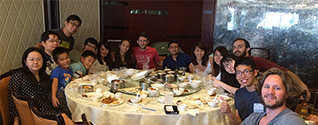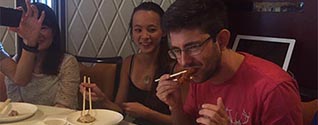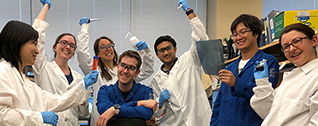Methods Carey Cell
Detailed methods for Carey’s paper, prior to cutting it down for cell.
Transgenic lines information
Generation of Myc tagged AGO4 and DRM2.
The genomic AGO4 sequence which contained 3.7 kb of endogenous AGO4 promoter was amplified from BAC T20P8 using primers 5’(TGGTCGCCGGAAAAGTCACTGCCGTATTC)3’ and 5’(CTCATATCAATACATAGATTGTCAAAATGAAT)3’ and subcloned into plant vector pCAMBIA1300a using SacI and XbaI restriction sites. ApaI and BamHI restriction sites were engineered immediately upstream of the AGO4 start codon using QuikChange Site-Directed Mutagenesis Kit (Stratagene). Four copies of c-Myc was amplified from a plasmid containing 6xMyc-DET1 (gift from Joanne Chory) using primers 5’(GAAGGGCCCATCCCCAAAGCTATG)3’ and 5’(GAAGGATCCTTGGATCGGGCTGCAGG)3’, and inserted in frame with AGO4 using the ApaI and BamHI restriction sites (Schroeder et al., 2002). This Myc-AGO4 plasmid was transformed into the Agrobacterium strain ASE. ago4-1 clk-st plants were transformed by vacuum infiltration as described in (Bechtold and Pelletier, 1998). Transformants were selected using hygromycin (50mg/ml). Myc-AGO4 lines which showed strong complementation and segregated 3:1 for the transgene were used for analysis and crosses. For analysis of GFP-SmD3 transgenic plants, Myc-AGO4 in the wildtype Columbia (Col) ecotype was used for transformation. Myc-AGO4 in Col was generated by transforming Col plants and selecting for hygromycin resistant transformants. Lines containing functional Myc-AGO4 in Col were verified by western blot analysis and immunolocalization in the nucleus using an antibody against c-Myc (Upstate). The Myc-AGO4 Col line which segregated 3:1 for the transgene was used for experiments.
Generation of Myc tagged DRM2
The DRM2 gene and flanking intergenic regions were PCR amplified using Pfx Taq Polymerase (Stratagene) from BAC clone T15N1 with primers JP2548 5’(GTAATGGAGATAGCTTCTCAGGATTATCATTAGC)3’ and JP2549 5’(AACCAGATTGGGGCAATATACATATAGAAGAGCC)3’. The PCR product was cloned into pCR4 (Invitrogen) and sequenced. Site-directed mutagenesis (QuikChange, Stratagene) was performed on this clone to introduce NheI and BamHI using primers JP2626 5’(GCGAGGATGAGAGGAGCTAGCTCAGGATCCTTACCTGAAGTAGATTGAAGTAGATATG)3’ and JP2627
5’(CATATCTACTTCAATCTACTTCAGGTAAGGATCCTGAGCTAGCTCCTCTCATCCTCGC)3’ at the stop codon of the DRM2 open reading frame. The 9xMyc epitope sequence was PCR amplified using Pfx from the pN-TAPa vector (gift from Xing Wang Deng) using primers JP2720 5’(GCTAGCATGGCGGGCCGCTCTAGAACTAGTGG)3’ and JP2721 5’(TGATCACTAGAGCCCGGGGGATCCACTAGTGG)3’ and cut with NheI and BclI and then cloned into the mutated stop site (Rubio et al., 2005). The Myc-tagged DRM2 gene was then cloned as an EcoRI fragment into the pCAMBIA1300 binary vector and transformed into drm1 drm2 cmt3 mutants using Agrobacterium strain ASE and floral dipping. First generation transformants were selected by growth on MS + hygromycin (50mg/ml) and assayed for complementation. The drm1 drm2 cmt3 triple mutant was generated and genotyped as previously described (Cao and Jacobsen, 2002a)
Generation of FLAG tagged RNPS1
RNPS1 (At1g16610) coding sequences were amplified from A. thaliana (Col-0) total RNA following reverse transcription and PCR amplification using Pfx Platinum DNA Polymerase and primers: 5’(caccTGGCGAAACCAAGTCGTGGC)3’ and 5’(TTAAGTTTTACGAGGTGGAGGTGGT)3’. PCR products captured in pENTR/D-TOPO were recombined into pEarleyGate 104 (Earley et al., 2006), fusing RNPS1 sequences C-terminal to FLAG expressed from a CaMV 35S promoter. This construct in Agrobacterium strain GV3101 were transformed into Col by the floral dip method (Clough and Bent, 1998). Transformants were selected using phosphinothricin.
Generation of GFP-SmD3 Myc-AGO4 transgenic plants
The plasmid containing GFP-SmD3 was a gift from Peter J. Shaw, and its generation is described in (Pendle et al., 2005). GFP-SmD3 was transformed into Agrobacterium strain AGL1. Myc-AGO4 Col plants were transformed by vacuum infiltration, and first generation plants containing GFP-SmD3 and Myc-AGO4 were used for analysis. The expression of GFP-SmD3 was verified by western blot analysis with a GFP antibody (Santa Cruz Biotechnology).
Analysis of Myc-AGO4 in mutants
The Myc-AGO4 line was crossed to various mutant lines for Myc-AGO4 localization and protein analysis in the homozygous mutants or their respective wildtype siblings. The dcl3 rdr2 double mutant was generated by crossing rdr2 and dcl3, and screening for homozygous double mutants. The dcl3 and rdr2 single mutants are described in (Xie et al., 2004). The drm2 mutant in the WS ecotype was genotyped using primers 5’(GGGGGCGGCCGCAGAAAGATCCAAACTCAAATGAA)3’ and 5’(GGGGCTGCAGCTACCCTCGGGCTAACTCTGGA)3’ for the wildtype allele, and primers 5’(CATTTTATAATAACGCTGCGGACATCTAC)3’ and 5’(GGGGCTGCAGCTACCCTCGGGCTAACTCTGGA)3’ for the mutant allele. The nrpd1a mutant (SALK 143437) was genotyped using primers 5’(AGCATTGACTTGGGCTctgc)3’ and 5’(CTGAAGCGGAAACAACTGAGC)3’ for the wildtype allele, and primers LBA1 and 5’(AGCATTGACTTGGGCTctgc)3’ for the mutant allele. The nrpd1b-1 mutant (SALK 029919) was PCR genotyped as described in (Pontier et al., 2005).
MEA-ISR cutting assay
Genomic DNA was digested with FokI and subjected to sodium bisulfite treatment as described in (Jacobsen et al., 2000). MEA-ISR was amplified by PCR using primers 5’(aaagtggttgtagtttatgaaaggttttat)3’ and 5’(CTTAAAAAATTTTCAACTCATTTTTAAAAAA)3’. PCR amplified products were digested with EcoRI and resolved by agarose electrophoresis. Presence of a full length (~360bp) or digested (~270bp) PCR product indicates the absence or presence of DNA methylation, respectively.
Immunofluorescence analysis
Preparation of nuclei from flowers or leaves without flow-sorting was performed as described (Jasencakova et al., 2003). Primary antibodies used in immunostaining included Myc (1:200, Upstate), H3K9me2 (1:200, Upstate), H3K27me3 (1:400, Upstate), NRPD1a (1:200), and NRPD1b (1:100). Secondary anti-mouse-Fluorescin (Abcam), anti-rabbit-Rodamine (Jackson ImmunoResearch), or anti-mouse-Rodamine (Abcam) were used for detection of nuclear protein. Vectashield® mounting medium containing DAPI (Vector Laboratories) was added to nuclei to prevent fading. Nuclear protein localization was captured at a 100X magnification using the Zeiss Axioskop 2 microscope with the Zeiss Axiocam HRC color digital camera system or the Zeiss AxioImager Z1 microscope with the Hamamatsu Orca-er camera. Images were analyzed using the Zeiss Axiovision software.
Quantitative RT-PCR analysis
RNA was isolated and cDNA was generated as previously described (Cao et al., 2003; Johnson et al., 2002). Real-time PCR amplification was performed using SYBR Green QPCR Master Mix (Stratagene) and primers 5’(AGAGCTTGGGCGACCTCA)3’ and 5’(GAGGAGGTGGTAATGCCTCA)3’. Data was analyzed using the Mx3000P software (Stratagene).
Flowering time analysis
The FWA flowering time anlaysis with the nrpd1b mutant and Col was performed as described in (Cao and Jacobsen, 2002). The nrpd1b mutant (SALK 033852) was genotyped using primers 5’(agcaaagtggtgatgcatgg)3’ and 5’(TTTGTGTCCCCAAACGTCAG)3’ for the wildtype allele, and primers LBA1 and 5’(TTTGTGTCCCCAAACGTCAG)3’ for the mutant allele.
Semi-quantitative western blot anlaysis
Flowers (0.3g) were frozen in liquid nitrogen, ground into powder with pestle, homogenized with 1 ml of protein extraction buffer (50 mM Tris-Cl pH 7.5, 150 mM NaCl, 5 mM MgCl2, 10% glycerol, 0.1% NP-40) containing fresh DTT (2 mM), PMSF (1 mM), pepstatin (0.7 mg/ml), MG132 (10mg/ml), and protease inhibitor cocktail (Roche), and centrifuged twice (13K rpm, 4°C). Equal total protein amounts were resolved on an 8% SDS polyacrylamide gel and transferred onto a nitrocellulose membrane. Western blot analysis was performed using a Myc antibody (Upstate).
Coimmunoprecipitation of AGO4 and RNA Pol IV
Cell lysate was prepared as described in the previous section using 0.7g of flowers and 2 ml of protein extraction butter. Equal total protein amounts were pre-cleared with Protein A-agarose beads (Pierce), followed by anti-NRPD1a or anti-NRPD1b incubation (1:250). Protein complexes were captured with Protein A-agarose beads, washed five times with extraction buffer, and boiled in SDS protein sample buffer. Immunoprecipitated proteins were resolved on an 8% SDS polyacrylamide gel and transferred onto a nitrocellulose membrane (Amersham). Copurified Myc-AGO4 protein was detected by western blot analysis with a Myc antibody.
Gel filtration analysis of Myc-AGO4
Myc-AGO4 lysate from flowers was prepared as described in the previous section. The lysate was additionally filtered through a 0.2 micron filter. Four mg of total protein was loaded onto a Superdex 200 10/300 GL column (Amersham), and 250 ml fractions were collected at 0.5 ml/min. The elution profile of Myc-AGO4 or NRPD1b was analyzed by western blot with antibodies against c-Myc or NRPD1b, respectively. To determine complex sizes, a standard curve was generated using calibration proteins apoferritin (480 kDa), gamma globulin (160 kDa), albumin bovine (67 kDa), chymotrypsinogen (24 kDa), and cytochrome c (13 kDa).
GST-CTD binding experiments
DNA fragment encoding for the NRPD1b CTD (from amino acid 1410 to 1874) was amplified from reverse-transcribed cDNA using specific primers. The PCR product was digested and ligated into the overexpression plasmid pET-41a(+) (Novagen). The resulting plasmid, pGST-CTD as well as the control plasmid pET-41a(+), were transformed into E. coli BL21. Freshly obtained transformants were grown at 37°C to an OD600 of 0.6 and the expression was then induced by the addition of IPTG at a final concentration of 1 mM. 3 h after induction, cells were disrupted using a French press, and the GST-fusion proteins were purified by glutathione-Sepharose 4B (Amersham Biosciences) affinity chromatography. The GST-CTD fusion protein was in vitro phosphorylated using casein kinase (New England Biolabs) as previously described for the RNA Pol II-derived GST-CTD fusion protein (Barilla et al., 2001). The phosphorylation of the CTD was assessed by electrophoresis in an SDS-polyacrylamide gel in which the phosphorylated form is indicated by its retarded mobility. Unphosphorylated and phosphorylated GST-CTD and GST proteins were immobilized onto 20ml of glutathione Sepharose 4B, and the coated beads were then washed and equilibrated with the IP buffer. A total of 150ml of flower whole cell extract was applied to the GST-CTD beads and mixed for 3 h at 4°C on a rotating wheel. The beads were then washed 3 times with the IP buffer, and the bound protein (pellet) was eluted with 60ml of SDS-PAGE sample buffer. All samples including the unbound proteins (supernatant) were separated by SDS-10% PAGE and subjected to Western blotting.
DNA and RNA FISH analysis
RNA probes were labeled by in vitro T7 polymerase (Ambion) transcription with digoxigenin-11-UTP or biotin-16-UTP RNA labeling mix (Roche). RNA in situ hybridization was carried out at 42°C overnight using a probe solution containing 1 μg RNA probe, as described previously (Highett et al., 1993). Slides were washed sequentially in 2X SSC, 50% formamide, 50°C followed by 1X SSC, 50% formamide, 50°C, then 1X SSC 20°C and finally TBS, 20°C. DNA-FISH using 5S or 45S rRNA gene probes labeled with biotin-dUTP or digoxigenin-dUTP was performed as described (Pontes et al., 2003). Digoxigenin-labeled probes were detected using mouse anti-digoxigenin antibody (1:250, Roche) followed by rabbit anti-mouse antibody conjugated to Alexa 488 (Molecular Probes). Biotin labeled probes were detected using goat anti-biotin conjugated with avidin (1:200, Vector Laboratories) followed by streptavidin-Alexa 543 (Molecular Probes). DNA was counterstained with DAPI (1μg/ml) in Vectashield solution (Vector Laboratories). For dual protein/nucleic acid localization experiments, slides were first subjected to immunofluorescence, then post-fixed in 4% formaldehyde/PBS followed by RNA or DNA-FISH. Nuclei were examined using a Nikon Eclipse E80i epifluorescence microscope, with images collected using a Photometrics Coolsnap ES Mono digital camera. The images were pseudocolored, merged, and processed using Adobe Photoshop (Adobe Systems, Mountain View, CA).







